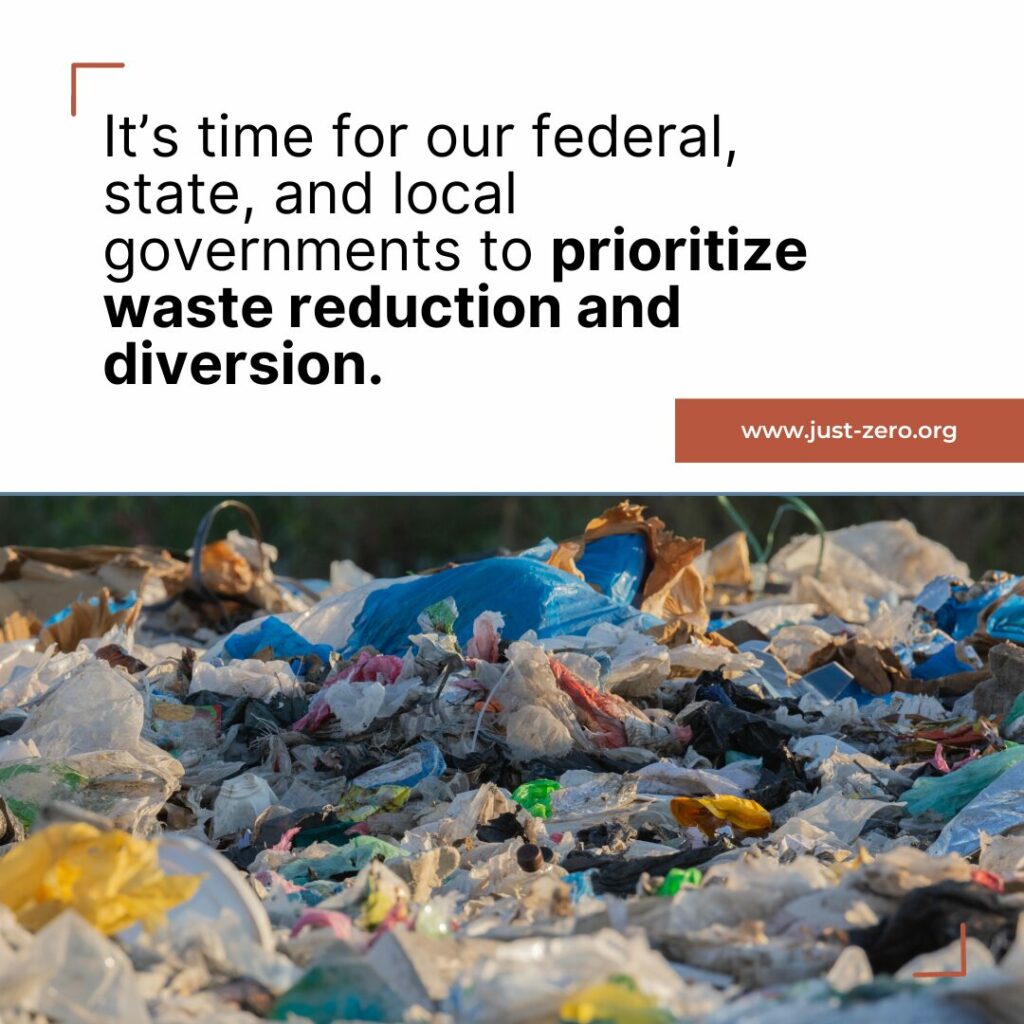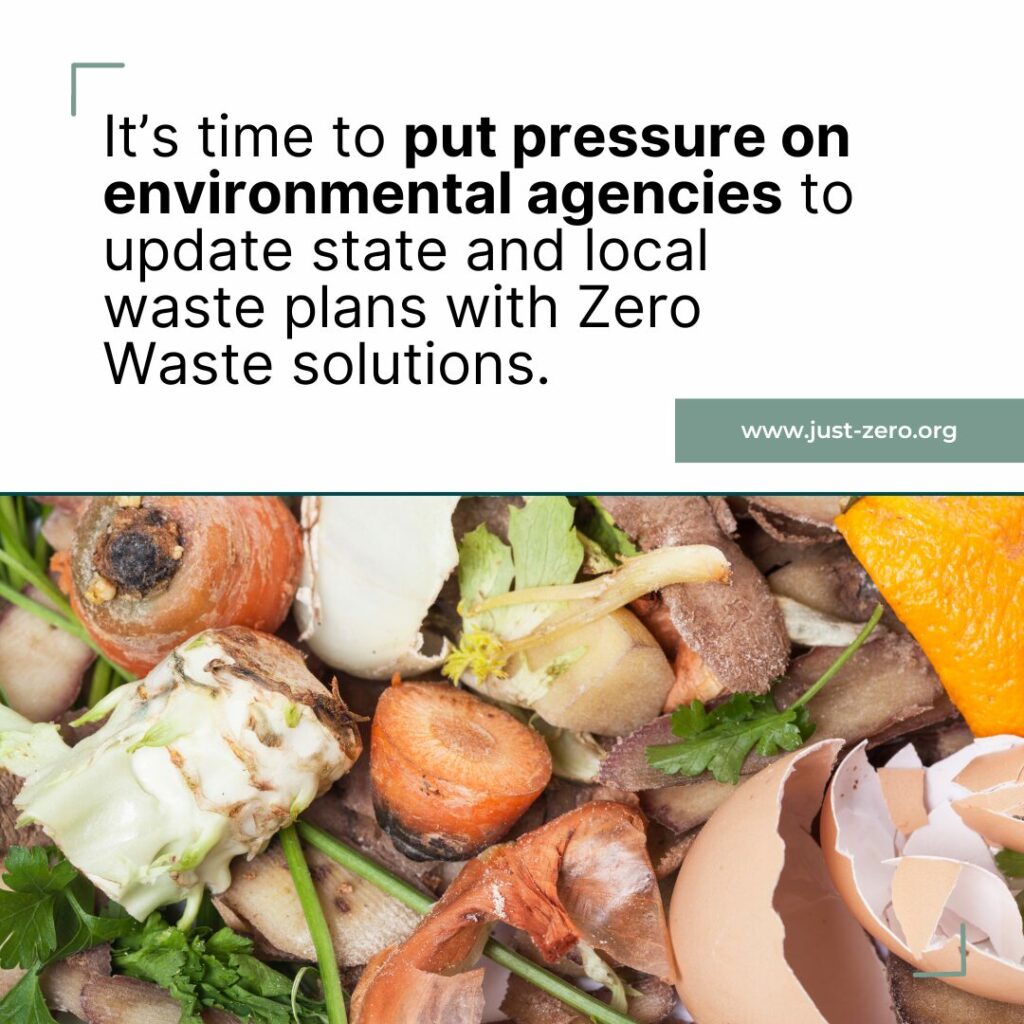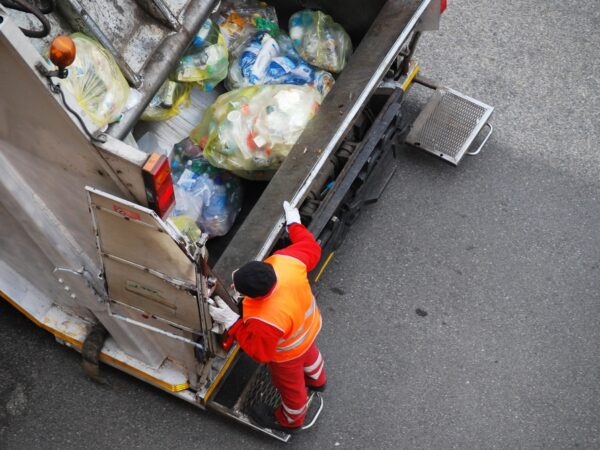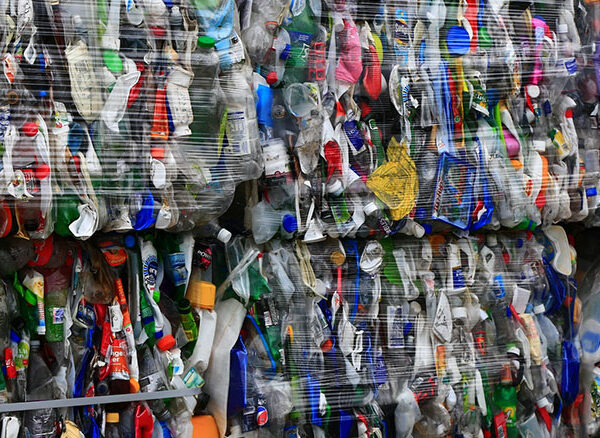Last updated April 10, 2024
The Big Picture
Our waste crisis is about so much more than just the individual choices that fill up our trash bins each week. Different choices will only get us so far when we’re facing a pervasive and systemic problem that impacts public health and our environment at every level. The United States produces about 300 million tons of waste each year. Most of that is buried in landfills or burned in incinerators. And more than 76 million people in the U.S. live within 3 miles of a landfill or incinerator. We cannot meaningfully address the toxic, climate-damaging, and inequitable impacts of burying and burning all that trash unless we stop waste before it starts.
If You Fail to Plan, You Plan to Fail
A systemic problem calls for systemic solutions. The good news is that many states, counties, and cities take a holistic look at the big picture using what are known as “solid waste management plans” (more on the problem with that name later, but for now let’s just call them waste plans). In fact, federal law requires states to implement waste plans and review them every three years.
The bad news? Our federal government doesn’t enforce this waste plan requirement. And most states (and many of the counties and cities that also develop waste plans) take a lackluster, business-as-usual approach to waste planning. As such, waste plans typically entrench the toxic and climate-damaging “make, burn, and bury” approach that has plagued our planet and our communities for decades. This makes it difficult, if not downright impossible, to navigate when, where, and how to urge your state, county, or city officials to pursue waste planning differently; in a way that prioritizes real solutions like waste reduction and diversion.
But Just Zero is here to help. We’ve designed this toolkit to help you advocate for meaningful, systemic changes to our waste systems so that your federal, state, and local government prioritize waste reduction and diversion – setting us on a path to Zero Waste.
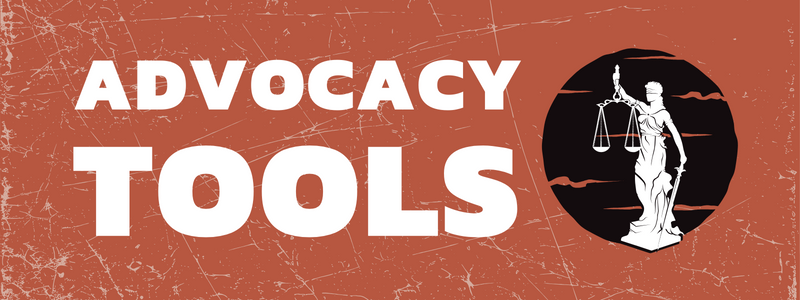
Federal vs State Laws – Who Sets the Rules for Solid Waste Management Plans?
Is your state, county, or city required to have a solid waste management plan? And how often must it be updated? Unfortunately, the answers to those questions are as messy and confusing as the waste crisis itself.
Expand to read more
The federal Resource Conservation and Recovery Act and its regulations require states to 1) develop and implement solid waste management plans, 2) review those plans every three years, and 3) revise the plans as needed. The U.S. Environmental Protection Agency does not, however, interpret this requirement as mandatory, and instead views the Act as merely “encouraging” states to develop solid waste management plans. The Agency, therefore, neither enforces the planning requirements of the Act against states, nor tracks the status of state solid waste management plans.
The lack of clear guidance from our federal environmental agency has created a patchwork approach to waste planning throughout the country. Many states, including Colorado, Delaware, Nevada, New York, North Carolina, and West Virginia require statewide solid waste management plans. Some states require their environmental agencies to periodically revise the plans – every 10 years in states like Arkansas and Massachusetts or every 5 years in states like Kansas and Maine. Other states, like Connecticut and Rhode Island, do not have a set schedule for reviewing and updating their plans. And many states, like Arizona, Illinois, Georgia, Maryland, Michigan, Pennsylvania, Texas, and Virginia, delegate waste planning to regional or county authorities.
Left to their own devices, some states haven’t required or adopted a solid waste management plan. And many states that do have statewide solid waste management plans, like Alabama, Missouri, and New Jersey, haven’t updated their plans in more than 15 years.
To find out more about the rules for waste planning in your state, we recommend starting with your state environmental agency. Or you can always reach out to Just Zero for help!
Where Do Most Solid Waste Management Plans Fall Flat?
It’s all about priorities. Most waste plans prioritize deciding what to do with our waste, which inevitably means endorsing false solutions like landfilling and incinerating, rather than asking how we stop waste before it starts.
Expand to read more
You don’t have to look much further than the name of these plans to understand the flawed approach taken by most states, counties, and cities. They’re called solid waste MANAGEMENT plans for a reason. Most planning authorities are simply looking at how to manage waste – how to collect it, what to do with it, where to send it. This unavoidably leads to the false choice between burying and burning waste. It’s this false choice that drives the waste crisis and distracts us from real solutions that prioritize reduction, reuse, and diversion.
Our governments need to stop viewing waste as an inevitability that needs to be managed. And they need to stop endorsing false solutions – especially those that involve burning waste – in the name of waste management. State and local plans from Connecticut to Florida mistakenly prioritize waste burning to achieve “self-sufficiency” or “zero waste to landfill.” And most plans – even those that set ambitious goals – ultimately focus on meeting “waste disposal needs,” rather than on eliminating, reducing, and diverting as much waste as possible.
The Right Solutions Start with the Right Data
To identify the best ways to reduce our waste, we first need to know what’s in our waste. And that means up-to-date, reliable “waste characterization data” that break down the different types of materials and products that end up in our trash.
Expand to read more
Unfortunately, not every state in the country has performed a waste characterization study analyzing its trash. And many of those that have done a waste characterization study haven’t updated their data in more than 10, or sometimes even 20, years.
These studies usually look at how much of a state’s trash is made up of items like glass, different types of plastic, food and other organics, textiles, and so on and so forth. If a waste plan is going to live up to its potential and implement a strategy for reducing each of these waste categories, it needs to start with reliable data.
Even with spotty or nonexistent data in many states, national data from the U.S. Environmental Protection Agency helps paint a picture of what’s in our waste. And that picture is alarming. More than 80% of our trash is paper, plastic, glass, metal, food, or other organics. Most of this waste either doesn’t belong in our trash bins and could instead be reused, recycled, composted, or – like so many of the single use packages and products in our trash – just shouldn’t exist in the first place.
Tell Your State, Regional, or Local Government That You Want a Better Plan
Start with the basics. If your waste plan is up for review or reconsideration, use the talking points below to urge your state, county, or city to develop and implement a plan that prioritizes tried and true methods of waste reduction like food waste bans, reuse and refill programs, bottle bills, packaging reduction laws, and pay-as-you-throw programs.
Almost 25% of the waste we bury and burn in the U.S. each year is wasted food. Laws and regulations that progressively ban all food waste from landfills and incinerators are one of the best solutions to dramatically eliminate and divert edible or compostable food, while also helping to address food insecurity. A phased-in ban on all food in the waste stream should be the centerpiece of any successful waste plan.
Read more about the benefits of these programs here.
Packaging waste alone makes up about 25-30% of our trash. The consumer brands that make, distribute, and profit from all this packaging have no incentive to reduce or redesign the products and containers that are so central to their single-use business model. A gradual approach to phasing out certain packaging types (only to see them replaced by single-use alternatives) can be slow, frustrating, and sometimes ineffective. Waste plans, however, provide a crucial opportunity for states to pursue effective packaging reduction and recycling programs that mandate a transition away from single-use packaging and toward reusable or easily recyclable options.
Read more about packaging reduction programs here.
Reuse is the single most effective way to eliminate waste before it starts, which should be the primary goal of any modern waste plan. Packaging and products that are designed from the get-go to be reused or refilled, coupled with the infrastructure and investments to support reuse and refill, can help reduce almost every segment of the waste stream. To move beyond shortsighted “management” of waste, waste plans can and should help implement the policies, systems, and investments that can make waste a thing of the past.
Read more about reuse and refill systems here.
Beverage containers can comprise up to 10% of the waste stream in states without Bottle Bills – recycling systems designed to collect, manage, recycle, and sometimes reuse, beverage containers. These systems, thanks to their financial incentives and producer-paid funding mechanisms, are a highly effective way to divert single-use packaging from the waste stream, and from our environment. And yet, only 10 states in the U.S. currently have Bottle Bills. Waste plans provide states, counties, and cities with important opportunities to urge legislators to implement, or modernize, Bottle Bill programs.
Read more about how the best Bottle Bills make an impact here.
Pay-as-you-throw programs, in which residents pay a fee for trash disposal depending on how much they throw away, dramatically reduce trash generation and disposal. To focus on waste reduction, rather than just “management,” every waste plan should incorporate a proposal for wide-scale implementation of pay-as-you-throw programs. Communities with these programs have reduced their trash by as much as 50%, or more, in as little as a year. When implemented alongside food waste prevention and recycling programs, packaging reduction, bottle bills, and other real solutions, pay-as-you-throw programs can make most of our household waste a thing of the past.
Read more about pay-as-you-throw successes here.
Don’t Let Your State Get Stuck on False Solutions
Far too many waste plans embrace seemingly impossible “miracle” solutions that claim to revolutionize waste and/or recycling. There’s a reason these false solutions sound too good to be true: They don’t work. In fact, they usually make the problem worse. Make sure your state, county, or city’s waste plan avoids these dangerous traps.
- Plastic Recycling is a Lie
- “Advanced Recycling” Is an Even More Dangerous Lie
- Don’t Empower Polluting Industries
- Don’t Mix Food Waste with Sewage Sludge
Any waste plan that leans too heavily on recycling – especially plastics recycling – is doomed to fail. Throughout the U.S., plastic usually makes up about 12%, or more, of our waste. And less than 6% of all the plastic in the U.S. is recycled each year – that’s because plastic was never designed to be recyclable. Instead, the companies that profit from single-use plastics – including major consumer brands, e-commerce giants, and big beverage companies – use the myth of plastics recycling to distract us from the fact that plastics are a toxic and climate-damaging nightmare. Why? Because they don’t want us to pursue the real solution: phasing out plastics once and for all. When it comes to plastic, waste plans must stop prioritizing recycling. Instead, these plans need to prioritize reducing and, as much as possible, stopping the creation of all this plastic trash in the first place.
Read more about the plastic recycling lie here.
The plastics industry isn’t content to just rely on the myth of “traditional” plastics recycling. As more states and cities move to ban certain single-use plastics, the industry is upping the stakes by pushing so-called “advanced recycling” as a supposed solution to the plastics problem. But “advanced recycling” amounts to little more than burning plastic waste. And it’s expensive, dangerous, toxic, and climate-damaging. To say the least, it has no place in any forward-looking waste plan.
Read more about the “advanced recycling” myth here.
Far too often, waste plans embrace an approach to waste “management” that empowers polluting industries that profit from the waste crisis – especially the plastics industry, consumer brands, waste haulers, and landfill and incinerator companies. Waste reduction, the primary goal of any worthwhile waste plan, will always be a threat to these industries. For a waste plan to serve its best purpose, it must not give these industries a role in charting the course for a state, county, or city.
Read more about the ways polluters try to manipulate systems to their own advantage here.
As states and cities take steps to divert wasted food from landfills and incinerators, some have misguidedly decided to mix the diverted food with sewage at wastewater treatment plants. The result is toxic, inefficient, and sometimes climate-damaging. Through waste plans, states, counties, and cities can and should rush to divert as much food waste as quickly as possible. But it is equally important that they avoid this dangerous false solution.
Read more about the dangers of mixing food waste with sewage sludge here.
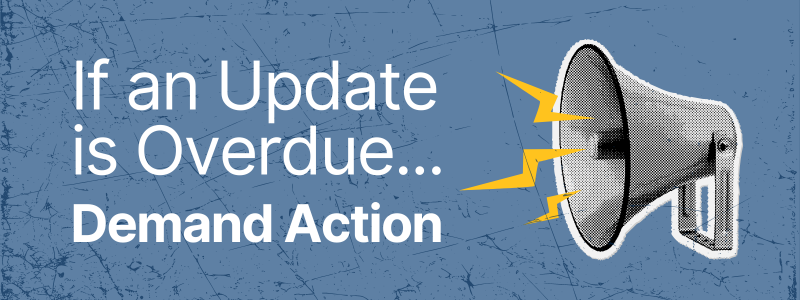
Even if your state, county, or city’s waste plan isn’t up for a formal review process any time soon, you can still use the resources in this toolkit to put pressure on your state or local environmental agency to act. Read more for a few ideas.
Select from menu for more details.
Contact Your State Agency
In most states, the relevant environmental agency, such as a department of environmental protection or environmental quality, is responsible for waste planning. A phone call or email to the agency can go a long way in determining the status of your state, county, or city’s waste plan and whether it may be up for review or revision any time soon.
Organize in Your Community
If an updated waste plan is overdue or you’re dealing with an old, out-of-date waste plan, it may be time to put some pressure on your state or local agency. Bringing together allies in your community is a great place to start! Talk to friends, neighbors, and colleagues about their frustrations with all the waste in our lives. The more folks that mobilize and demand action on a new waste plan, the better.
Start a Petition
If you have a new or existing group of concerned residents, it might be time to put together a petition. Use talking points from this toolkit or our other resources to draft a letter to your agency demanding action on a new or updated waste plan.
Write a Letter to the Editor
This is a great way to get your message to a bigger audience, and simultaneously put pressure on your government to act. Use your own experiences, and solutions from this toolkit, to craft a message about reducing waste through proper planning in your state, county, or city that will resonate with readers and policymakers.
Spread the Word
Our waste crisis is about so much more than just the individual choices that fill up our trash bins each week. But we cannot meaningfully address the toxic, climate-damaging, and inequitable impacts of burying and burning all that trash unless our governments take action to make large-scale systemic change. Help us spread the word – we’ve created some language for you to use when sharing our toolkit!
